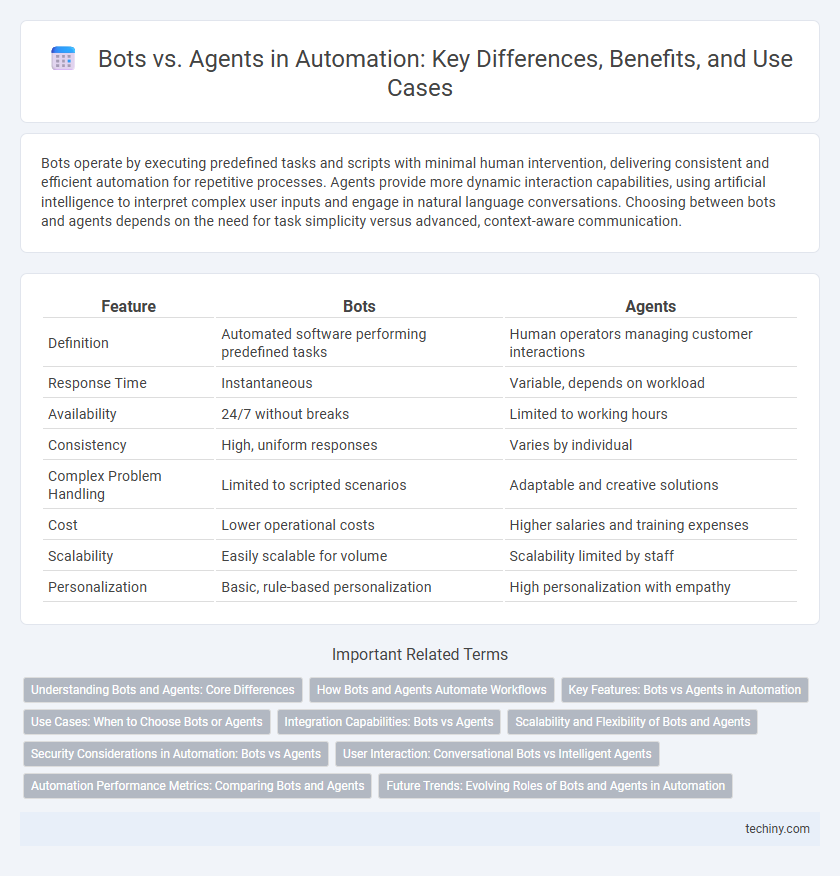Bots operate by executing predefined tasks and scripts with minimal human intervention, delivering consistent and efficient automation for repetitive processes. Agents provide more dynamic interaction capabilities, using artificial intelligence to interpret complex user inputs and engage in natural language conversations. Choosing between bots and agents depends on the need for task simplicity versus advanced, context-aware communication.
Table of Comparison
| Feature | Bots | Agents |
|---|---|---|
| Definition | Automated software performing predefined tasks | Human operators managing customer interactions |
| Response Time | Instantaneous | Variable, depends on workload |
| Availability | 24/7 without breaks | Limited to working hours |
| Consistency | High, uniform responses | Varies by individual |
| Complex Problem Handling | Limited to scripted scenarios | Adaptable and creative solutions |
| Cost | Lower operational costs | Higher salaries and training expenses |
| Scalability | Easily scalable for volume | Scalability limited by staff |
| Personalization | Basic, rule-based personalization | High personalization with empathy |
Understanding Bots and Agents: Core Differences
Bots are automated software designed to perform repetitive tasks with minimal human intervention, primarily executing straightforward commands within predefined parameters. Agents operate with greater autonomy, often incorporating artificial intelligence to perceive their environment, learn from interactions, and make decisions based on complex data inputs. The core difference lies in bots' rule-based automation versus agents' adaptive, intelligent behavior that enables dynamic problem-solving and enhanced user engagement.
How Bots and Agents Automate Workflows
Bots automate workflows by executing predefined, repetitive tasks with precision and speed, reducing human error and increasing efficiency in processes such as data entry, scheduling, and customer interactions. Agents use artificial intelligence to understand context, make decisions, and adapt workflows dynamically, enabling complex problem-solving and personalized user engagement. Combining bots for routine tasks and agents for adaptive functions streamlines operations and enhances overall workflow automation capabilities.
Key Features: Bots vs Agents in Automation
Bots in automation are software programs designed to perform repetitive, rule-based tasks efficiently, such as data entry, web scraping, and simple customer interactions, offering high scalability and speed. Agents provide more complex, adaptive capabilities by leveraging artificial intelligence and machine learning to understand context, make decisions, and handle dynamic workflows, often used in customer service and process optimization. Key features differentiating bots and agents include the level of autonomy, with bots following predefined rules and agents exhibiting cognitive abilities for problem-solving and real-time adjustments.
Use Cases: When to Choose Bots or Agents
Bots excel in handling repetitive, rule-based tasks such as data entry, customer FAQs, and simple transaction processing, ensuring efficiency and round-the-clock availability. Agents are preferable for complex, context-sensitive interactions requiring emotional intelligence, problem-solving skills, and personalized customer support. Organizations should deploy bots for high-volume, standardized workflows and engage agents for scenarios demanding nuanced understanding and human judgment.
Integration Capabilities: Bots vs Agents
Bots typically offer seamless integration capabilities with various APIs and software platforms, enabling automated task execution across diverse systems. Agents, often powered by AI, provide more dynamic integration through natural language processing and decision-making, allowing them to interact adaptively with multiple data sources and user inputs. Both solutions enhance workflow efficiency, but agents excel in environments requiring complex contextual understanding and real-time interaction across integrated systems.
Scalability and Flexibility of Bots and Agents
Bots excel in scalability by efficiently handling repetitive tasks across multiple platforms simultaneously, enabling organizations to process large volumes of data and interactions without compromising speed. Agents offer superior flexibility through human judgment and adaptability in complex, nuanced situations that require emotional intelligence and personalized responses. Combining bots for scalable automation with agents for flexible problem-solving creates a dynamic system that optimizes productivity and customer satisfaction.
Security Considerations in Automation: Bots vs Agents
Bots in automation often present security risks such as vulnerability to hacking and unauthorized access due to their predefined scripts and lack of adaptive intelligence. Agents, equipped with advanced machine learning capabilities, can dynamically detect anomalies and respond to potential threats, enhancing overall system security. Implementing robust authentication and continuous monitoring is critical to mitigating risks associated with both bots and agents in automated environments.
User Interaction: Conversational Bots vs Intelligent Agents
Conversational bots specialize in automating user interactions through predefined scripts and natural language processing, enabling efficient responses to common queries in customer service. Intelligent agents leverage advanced AI techniques, such as machine learning and context awareness, to deliver personalized and adaptive user experiences by understanding intent and evolving through interaction history. The distinction lies in conversational bots' task-specific automation versus intelligent agents' ability to manage complex, context-driven dialogues across multiple channels.
Automation Performance Metrics: Comparing Bots and Agents
Bots demonstrate superior efficiency in automation performance metrics by handling repetitive tasks with consistent speed and accuracy, significantly reducing error rates compared to human agents. Agents, while slower, excel in complex problem-solving and adaptability where nuanced decision-making and emotional intelligence are required. Key performance indicators such as average handling time, first contact resolution, and customer satisfaction often reflect bots' advantage in volume-based metrics, whereas agents outperform in scenarios requiring contextual understanding and personalized service.
Future Trends: Evolving Roles of Bots and Agents in Automation
Bots increasingly leverage artificial intelligence and machine learning to handle complex, context-aware tasks, enhancing automation efficiency across industries. Agents, equipped with advanced decision-making capabilities and human-like interaction, are evolving to manage sophisticated workflows and personalized customer experiences. Future trends suggest a convergence where bots and agents collaborate seamlessly, driving intelligent automation and transforming operational paradigms.
Bots vs Agents Infographic

 techiny.com
techiny.com